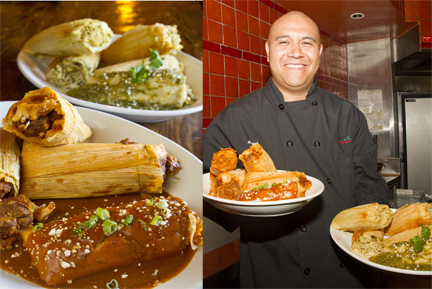 Tamales originated with the Mayans. They served as the equivalent of a sandwich, easily portable for armies, hunters, and travelers. They were also served at Aztec and Mayan feasts filled with pre-Columbian specialties such as frog, gopher, bees, honey, squash blossom, or beans. Modern versions come with more familiar fillings and still provide delicious, satisfying meals. Often prepared as a family enterprise for holidays, this ethnic comfort food has crossed the border with traditional and innovative interpretations.
Tamales originated with the Mayans. They served as the equivalent of a sandwich, easily portable for armies, hunters, and travelers. They were also served at Aztec and Mayan feasts filled with pre-Columbian specialties such as frog, gopher, bees, honey, squash blossom, or beans. Modern versions come with more familiar fillings and still provide delicious, satisfying meals. Often prepared as a family enterprise for holidays, this ethnic comfort food has crossed the border with traditional and innovative interpretations.
At Mi Casa in Costa Mesa, Chef Angel Velazquez serves pork and chicken tamales (see photos) year round, with strawberry and pineapple for the holidays. The pork tamale, a long-time customer favorite, is made from a Valazquez family recipe. “Our pork tamales are stuffed with tender cubes of pork meat on asavory red sauce seasoned with cumin, garlic salt, oregano, paprika, and chilis,” says Velazquez.
His chicken tamale is filled with shredded chicken breast cooked in salsa verde with poblano peppers, cumin, garlic salt, oregano, tomatillos, jalapenos, and other spices. “Our tamales are some of the biggest around, generously stuffed with more meat than regular tamales andserved with either our traditional red or salsa verde.”
Per tradition, Velazquez grew up watching his mom, aunt, and grandmother make tamales as part of holiday festivities. “My grandma used to lecture mymom and aunts, Remember to take your time, make them with passion, and don’t take any short cuts.’ What I learned from Grandma is the secret to my tamales.”
Some of those secrets include to, “Wrap on a corn husk. It’s traditional plus easy to work with. The husk needs to soak overnight in a water bath. The masa has to be moist, fluffy, and blended with the right amount of ingredients. If you over do it, the masa loses its texture and will dry too much.”
A cheese and jalapeno tamale may be on the menu soon at Mi Casa. Hot chocolate or champurrado a traditional warm beverage made of chocolate, pilloncillo (hard cones of unrefined sugar), corn masa, milk, and cinnamon are good pairings.
Mole tamales are one of the specialties from the Oaxaca region served at El Fortin Restaurant. Owner Mario Ramirez, originally from Oaxaca, serves several hand-made varieties at his Fullerton and Stanton locations. His Tamal Oaxaqueno de Mole Negro is filled with shredded pork or chicken and a richly flavored, not too spicy dark sauce. A tamale unique to Oaxaca is Tamal de Chepil. The savory pre-Hispanic herb is blended into the masa for a meatless tamale. Tamal de Rajas is stuffed with chicken, fried onions, tomatoes, and chili. Ramirez also prepares chicken with yellow mole and the traditional sweet tamale with pineapple and raisins.
At El Fortin, the beverage ordered most in winter with tamales is champurrado. For hot days, Ramirez recommends, ” Horchata, a rice water with cinnamon and we put pieces of melon, nuts, and red atun (cactus fruit) on the top.”
 At El Lobo, a recently opened restaurant in Long Beach, Chef/owner Sonia Gomez is making Latin food with roots; serving an eclectic collection of family recipes and regional dishes with her own twists. Seafood is used in her native Nayarit, a region on Mexico’s Pacific coast. The unusual Humitas del Mar is a Peruvian style sweet corn tamale topped with fresh scallops in a cayenne, lemon cream sauce.
At El Lobo, a recently opened restaurant in Long Beach, Chef/owner Sonia Gomez is making Latin food with roots; serving an eclectic collection of family recipes and regional dishes with her own twists. Seafood is used in her native Nayarit, a region on Mexico’s Pacific coast. The unusual Humitas del Mar is a Peruvian style sweet corn tamale topped with fresh scallops in a cayenne, lemon cream sauce.
She prefers banana leaves to wrap tamales because, “The masa stays very moist and smooth. Very different from a basic tamale,” she says. As a side to several entrees, she serves a small sweet tamale.
Her mole tamale pictured above (see recipe) is done with a sweet and spicy dark sauce. She recommends red wine as a pairing.












